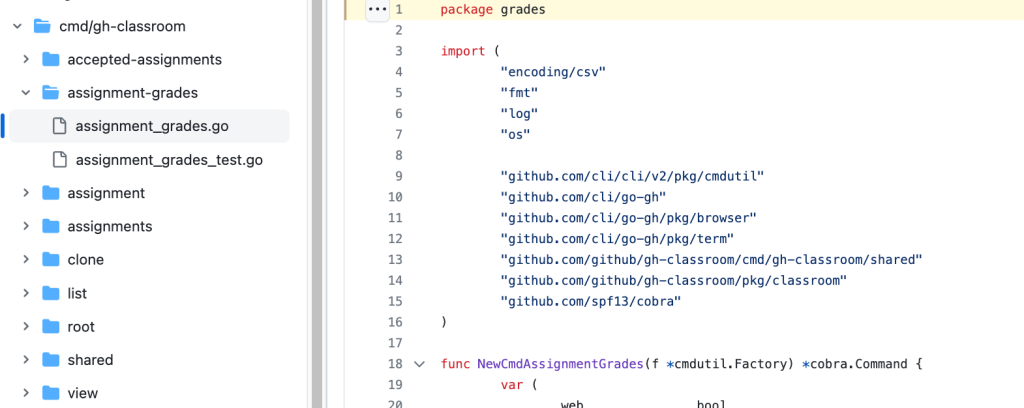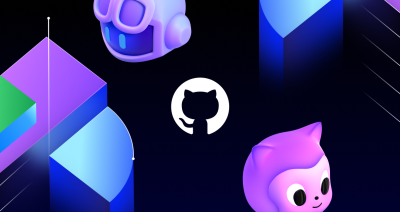Calling all teachers! Learn how to build new commands on the GitHub Classroom CLI
In this step-by-step tutorial, we’ll dive into how you can become the next open source contributor to the GitHub Classroom CLI, building commands that you can use to improve your workflow as an educator!

Teachers are essential in training the next generation of software developers. In order to do your best work as an educator and support your students, you need tools that meet your unique needs and use cases. With the power of open source, you can now build the features that you would like to see in the GitHub Classroom extension for the GitHub CLI.
The GitHub CLI is a free and open source tool that brings the features of GitHub to your terminal. The GitHub Classroom extension adds powerful and easy to use commands that enhance the functionality of the GitHub CLI, specifically tailored for educators using GitHub Classroom. This post will walk you through the steps to create a new command customized to you and contribute back to the open source community!
1. Set up your development environment
The GitHub Classroom extension for the GitHub CLI is a Go based project. Your contributions will be made through a pull request from your personal fork of the repository. The instructions to set up your development environment and fork are described step by step in our contribution guidelines!
2. Plan your feature
We acknowledge that every classroom is unique and we want to support broader personalization of the GitHub Classroom CLI. At the time of writing this tutorial, the following commands are available:
- accepted-assignments: List your student’s accepted assignments
- assignment: Show the details of an assignment
- assignment-grades: Download a CSV of grades for an assignment in a classroom
- assignments: Display a list of assignments for a classroom
- clone: Clone starter code or a student’s submissions
- list: List classrooms
- view: Show the details of a classroom
Have a feature in mind? Be sure to open an issue before you begin your work.
Looking for a way to contribute but don’t know where to start? Check out the open feature requests and bug issues in the gh-classroom repository. If you decide to work on one of these issues, assign yourself and link the issue to your pull request!
3. Determine the availability of the data required for your command
The GitHub Classroom API documentation has the most up-to-date information about the available REST endpoints. You will need to ensure that you can request the data needed for your feature from one or more of these endpoints. To make it even simpler, there is already a helper library in the project to query these endpoints.
As an example in this tutorial, let’s look at the assignment-grades command. In order to build this feature, we had to make use of the /assignment/:id/grades endpoint.
func GetAssignmentGrades(client api.RESTClient, assignmentID int) ([]AssignmentGrade, error) {
var response []AssignmentGrade
err := client.Get(fmt.Sprintf("assignments/%v/grades", assignmentID), &response)
if err != nil {
return nil, err
}
return response, nil
}
What if the data you need isn’t available through any of the public API endpoints? If you run into this roadblock, don’t worry, we’re here to help. Simply open an issue describing the information you need for your feature. We will triage this issue as soon as possible in order to unblock you.
4. Build your command package
Each command is contained within a Go package. Following the same example as above, the assignment-grades package is titled grades.

To start building your new command, create a new package directory and files from the root of your fork using the commands below:
mkdir ./cmd/gh-classroom/$my-feature-name && cd ./cmd/gh-classroom/$my-feature-name
touch $my-feature-name.go $my-feature-name-test.go
Within each of your newly created files on the first line, write package $my-feature-name to include it in your package.
5. Write and test your code
It’s your time to write your shiny new feature and shine as a software developer! If you’re feeling stuck, check out the code and tests for the existing commands in the cmd/gh-classroom directory.
When you’re done coding up a storm, run the tests using the following commands from the root of your fork:
go test -v ./…
golangci-lint run
Be sure that all of your code is tested and that all tests pass before moving on to the next steps. Reviewers will require this before your changes can be merged.
6. Register your package as a command
In order for your feature to work in the CLI, your package needs to be included in the root package using the AddCommand helper function.
cmd.AddCommand(assignmentgrades.NewCmdAssignmentGrades(f))
7. Commit, push, and open a pull request
Once you’re done writing your feature, you will need to commit the code and push it up to your fork. Before opening a pull request ensure that you have read the contribution guidelines to increase the likelihood of your changes being accepted. Finally, you can open a pull request against the official gh-classroom repository.
8. Wait for a review from a maintainer
You’re almost at the finish line! At this point you can sit back and wait for our comments, request for changes, or approval. The GitHub Classroom CLI is maintained by GitHub staff and the community. We will do our best to respond in a timely manner.
Please kindly note that there may be instances where a feature is not one that we would like to support. We cannot guarantee that your feature will be approved.
9. Use your new feature
If your pull request is accepted you can merge it into the main branch of gh-classroom. Next, one of our administrators will create a new release that will trigger a GitHub Action. Once the action is successfully completed, you can update the CLI in your terminal using gh extension upgrade classroom. The next time you run gh classroom -h you will see your new command.
Voila, you are now an open source contributor to the GitHub Classroom CLI!
Conclusion
This post walked you through the power of open source, and showed how to build custom features in the Classroom extension for the GitHub CLI. We’re thrilled that you’ve taken the time to consider contributing to this project. Your help is essential for ensuring that this tool is, and continues to be great.
We’d love to hear from you! If you have any questions or have feedback, please feel free to open an issue in the gh-classroom repository.
Tags:
Written by
Related posts

Why developer expertise matters more than ever in the age of AI
AI can help you code faster, but knowing why the code works—and sharpening your human-in-the-loop skills—is what makes you a great developer.

How to create issues and pull requests in record time on GitHub
Learn how to spin up a GitHub Issue, hand it to Copilot, and get a draft pull request in the same workflow you already know.

The difference between coding agent and agent mode in GitHub Copilot
We’ll decode these two tools—and show you how to use them both to work more efficiently.